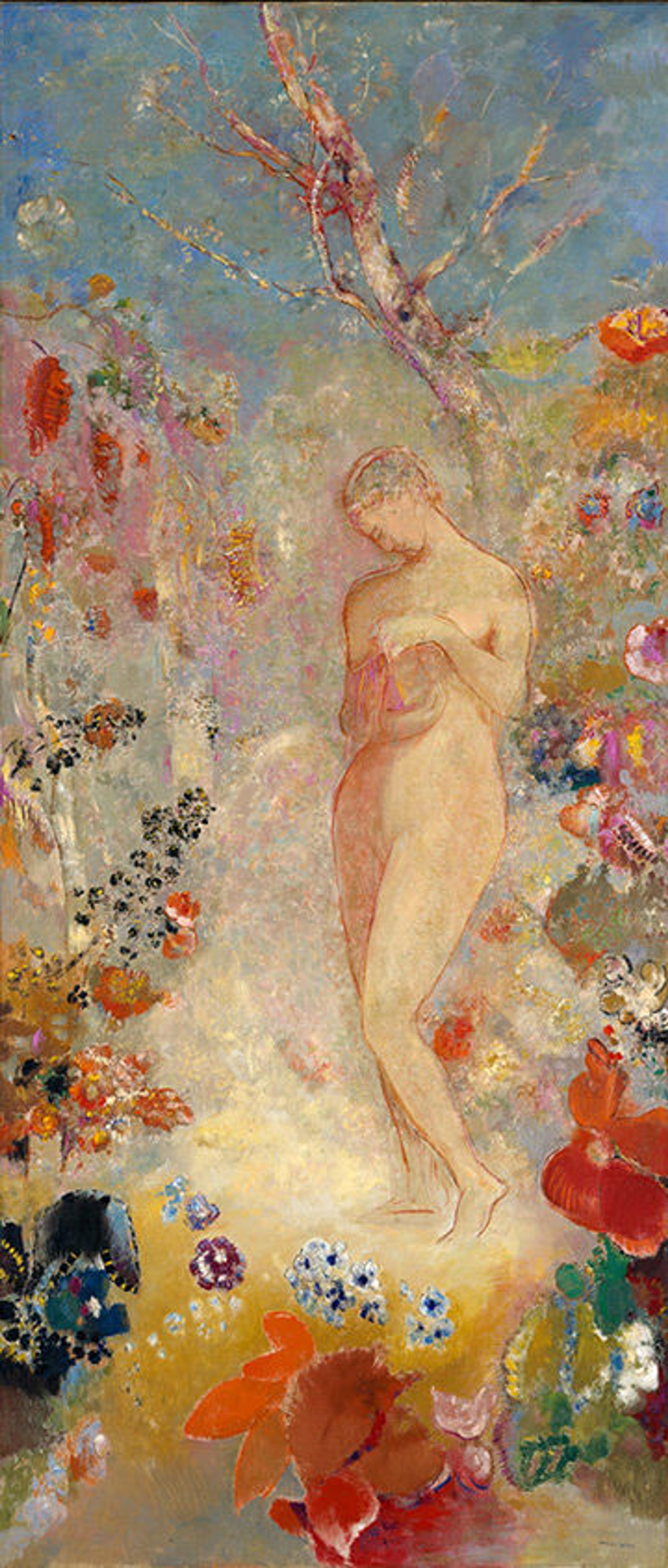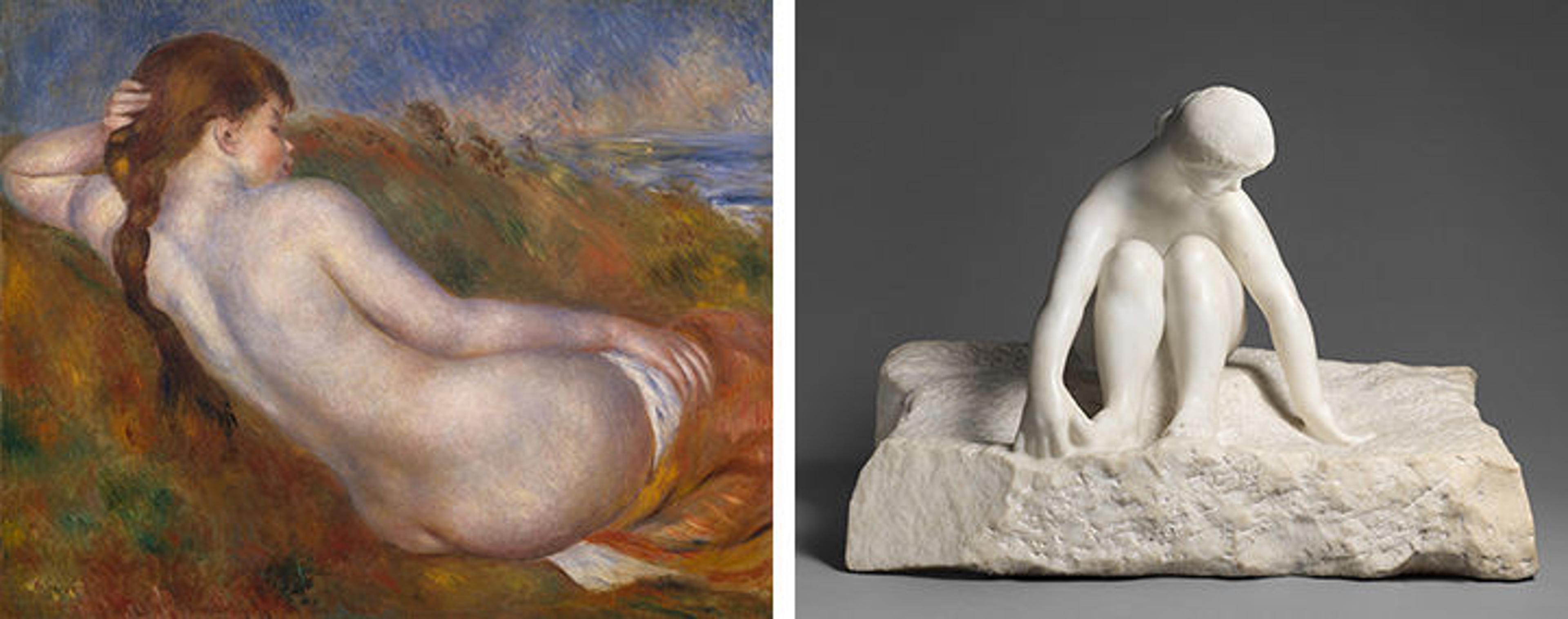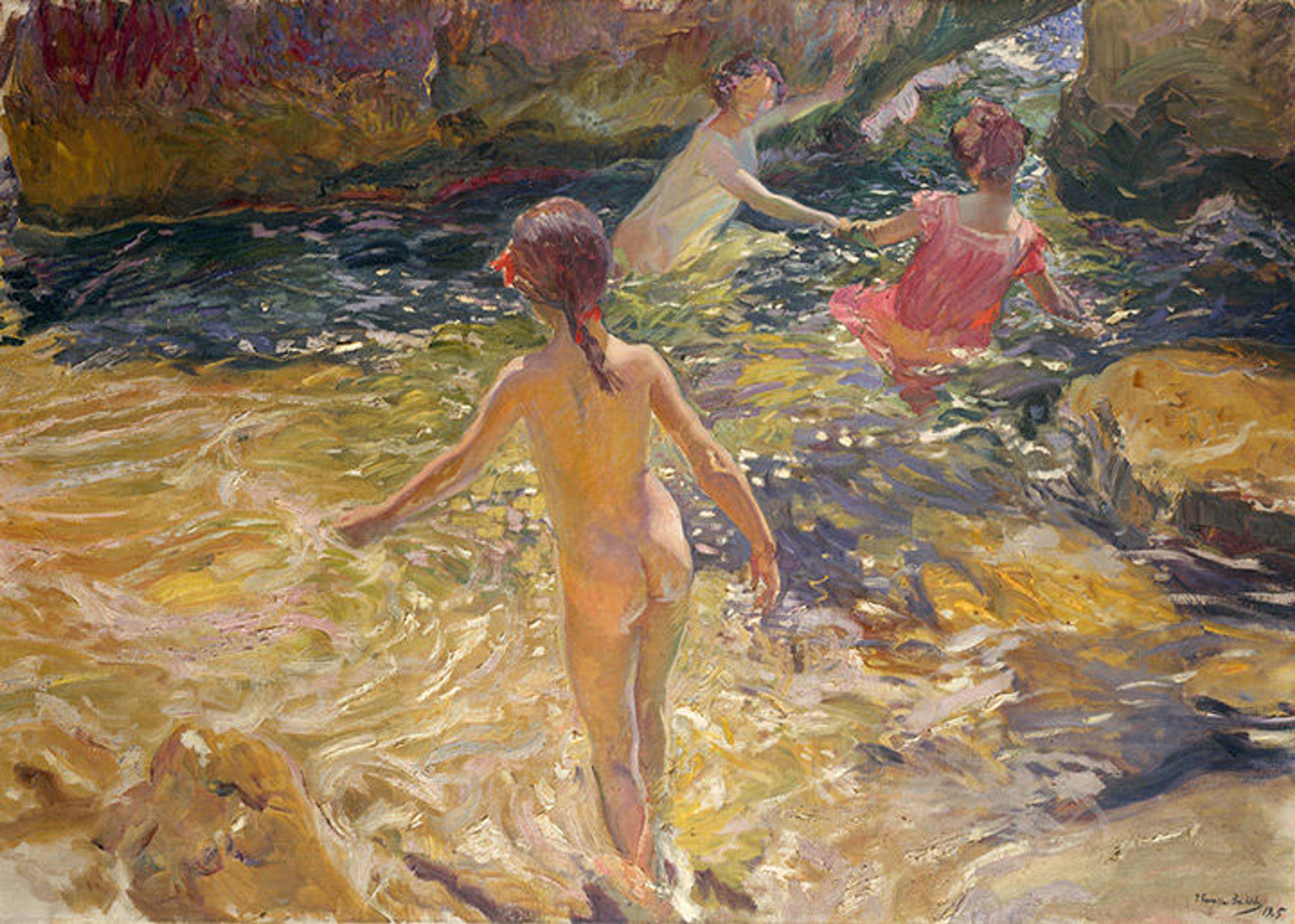
Left: Franz von Stuck (German, 1863–1928). Inferno, 1908. Oil on canvas, 50 3/4 x 82 1/2 in. (128.9 x 209.6 cm). The Metropolitan Museum of Art, New York, Purchase, Bequest of Julia W. Emmons, by exchange; Walter and Leonore Annenberg Acquisitions Endowment Fund; Charles Hack and the Hearn Family Trust and Mugrabi Family Gifts; Louis V. Bell, Harris Brisbane Dick, Fletcher, and Rogers Funds and Joseph Pulitzer Bequest; Pfeiffer Fund; Theodocia and Joseph Arkus and several members of The Chairman's Council Gifts, 2017 (2017.250). Right: Auguste Rodin (French, 1840–1917). The Thinker, modeled ca. 1880, cast ca. 1910. Bronze, 27 5/8 in. The Metropolitan Museum of Art, New York, Gift of Thomas F. Ryan, 1910 (11.173.9). Photo by the author
«One of the challenges of curating the paintings section of Rodin at The Met was choosing pictures from the Museum's collection that resonated with Rodin's sculptures visually, thematically, and historically. Some of the selections were obvious, such as Franz von Stuck's Inferno, a recent acquisition that was probably inspired by Rodin's The Gates of Hell; and paintings by the muralist Pierre Puvis de Chavannes, who was a great friend of Rodin and shared the sculptor's passion for classical antiquity.»

Rodin's sculpture of Pierre Puvis de Chavannes, flanked by two of the painter's works. Left: Pierre Puvis de Chavannes (French, 1824–98). Cider, ca. 1864. Oil on paper, laid down on canvas, 51 x 99 1/4 in. (129.5 x 252.1 cm). The Metropolitan Museum of Art, New York, Purchase, Catharine Lorillard Wolfe Collection, Wolfe Fund, 1926 (26.46.1) Center: Auguste Rodin (French, 1840–1917). Pierre Puvis de Chavannes, modeled ca. 1890, cast ca. 1910. Bronze, 21 x 20 x 12 1/2 in. (53.3 x 50.8 x 31.8 cm). The Metropolitan Museum of Art, New York, Gift of Thomas F. Ryan, 1910 (11.173.8). Right: Pierre Puvis de Chavannes (French, 1824–98). The River, ca. 1864. Oil on paper, laid down on canvas, 51 x 99 1/4 in. (129.5 x 252.1 cm). The Metropolitan Museum of Art, New York, Catharine Lorillard Wolfe Collection, Wolfe Fund, 1926 (26.46.2). Photo by the author
But other parts of the hang took longer to puzzle out. One area of the wall that went through several revisions was the section of the wall between Rodin's Honoré de BalzacandHead of Balzac, and his Cupid and Psyche.

Drawing by Senior Exhibition Designer Zoe Florence
An early installation plan (below) shows the wall hung with portraits by Édouard Manet, Gustave Courbet, and Carolus-Duran. The portraits were intended to complement the head studies at left, but the paintings didn't speak to the sculptures stylistically or historically, nor did they command the wall in the way I would have liked.

An early diagram showing experimentation with hanging paintings by Édouard Manet, Gustave Courbet, and Carolus-Duran. Drawing by Senior Exhibition Designer Zoe Florence

Right: Odilon Redon (French, 1840–1916). Pandora, ca. 1914. Oil on canvas, 56 1/2 x 24 1/2 in. (143.5 x 62.2 cm). The Metropolitan Museum of Art, New York, Purchase, Bequest of Alexander M. Bing, 1959 (60.19.1)
So instead I tried The Met's two Odilon Redon paintings in the spot: The Chariot of Apollo and Pandora.
Redon and Rodin were exact contemporaries—they were both born in 1840 and died within a year of each other. The mythological subjects of Redon's paintings, particularly the graceful female nude in Pandora, were a nice accompaniment to Cupid and Psyche. Redon's emphasis on shape and contour over precise detail, and his chalky, textured application of paint harmonized with the sculptures in this section of the gallery. But the pairing lacked a strong historical basis: although Redon and Rodin were contemporaries, they don't appear to have moved in the same circles. For the debut of our installation, I wondered if we could find something that communicated more directly the context in which Rodin worked.
A colleague suggested that I look more closely at Impressionist artists whom Rodin collected and with whom he exhibited. Excellent idea! My fellow curators and I had already decided to include two paintings by Claude Monet in the installation, but they were not enough to convey the depth of Rodin's engagement with Impressionist painters. Thanks to the Musée Rodin website, I discovered that Rodin owned a painting by Renoir of a female nude.

Left: Auguste Renoir (French, 1841–1919). Nude in the Sunlight, ca. 1880. Oil on canvas, 25 1/2 x 32 in. (64.9 x 81.4 cm). Musée Rodin (P.7334)
Rodin admired the sculptural qualities of this figure: its strong contours and firm modeling. He even once compared Renoir to Praxiteles, the celebrated ancient Greek sculptor of the female nude. As it happens, The Met owns a wonderful Renoir from the same period as Nude in the Sunlight. The sinuous curves and serene pose of the model in The Met's picture perfectly complemented Rodin's Beside the Sea, displayed across the room.

Left: Auguste Renoir (French, 1841–1919). Reclining Nude, 1883. Oil on canvas, 25 5/8 x 32 in. (65.1 x 81.3 cm). The Metropolitan Museum of Art, New York, Purchase, The Walter H. and Leonore Annenberg Collection, Bequest of Walter H. Annenberg, 2002 (2003.20.12). Right: Auguste Rodin (French, 1840–1917). Beside the Sea, ca. 1907. Marble, 23 1/2 x 34 1/2 x 23 1/4 in. (59.7 x 87.6 x 59.1 cm). The Metropolitan Museum of Art, New York, Gift of Thomas F. Ryan, 1910 (11.173.5)
That left one open spot on the wall. I wondered if I should I fill it with another Renoir, but that seemed like overkill. Perhaps a Camille Pissarro nude? He and Rodin were part of the same artistic milieu and appreciated each other's work.

Camille Pissarro (French, 1830–1903). Bather in the Woods, 1895. Oil on canvas, 23 3/4 x 28 3/4 in. (60.3 x 73 cm). The Metropolitan Museum of Art, New York, Purchase, H. O. Havemeyer Collection, Bequest of Mrs. H. O. Havemeyer, 1929 (29.100.126)
In the end, Pissarro's bather seemed too un-idealized and his style too different from anything else in the gallery. Then I remembered Joaquín Sorolla's The Bath, Jávea, a painting that I like very much and that had been in storage for a while. This was a great opportunity to put it on view.

Joaquín Sorolla y Bastida (Spanish, 1863–1923). The Bath, Jávea, 1905. Oil on canvas, 35 1/2 x 50 1/2 in. (90.2 x 128.3 cm). The Metropolitan Museum of Art, Purchase, Catharine Lorillard Wolfe Collection, Wolfe Fund, 1909 (09.71.2)
Left: Auguste Rodin (French, 1840–1917). Psyche, ca. 1905–13. Bronze cast of a plaster given as a gift to Joaquín Sorolla y Bastida. Museo Sorolla, Madrid

The high-keyed palette and the subject of The Bath, Jávea worked well with Renoir's Reclining Nude, and the swift, vigorous strokes of blue, green, and brown paint in the rocks and sea provided a nice transition to the Monet riverscape on the other side of Cupid and Psyche. The motif of the bathing nude, the varied brushwork, and the interplay of light and shadow corresponded well with Rodin's sculptures. Interestingly, Sorolla visited Rodin's studio in 1913 and received a statuette of a female nude as a souvenir—a history that highlights the sculptor's international fame in the early 20th century.
The rest of the curatorial team agreed. Here is the current hang in Rodin at The Met:

From left: Eugène Carrière's Self-Portrait, Rodin's Honoré de Balzac and Head of Balzac, Renoir's Reclining Nude, Sorolla's The Bath, Jávea, Rodin's Cupid and Psyche, and Monet's Rapids on the Petite Creuse at Fresselines in gallery 800. Photo by the author
The installation of paintings and sculpture will remain even after Rodin at The Met officially closes on January 15, 2018, and we'll continue to experiment with the display, bringing in different works and exploring new connections.
Related Content
Read a blog series on Rodin at Now at The Met.
See more digital content related to Rodin at The Met.
Heilbrunn Timeline of Art History: "Auguste Rodin"